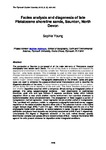Facies analysis and diagenesis of late Pleistocene shoreline sands, Saunton, North Devon
| dc.contributor.author | Young, S. | |
| dc.date.accessioned | 2019-05-15T14:06:58Z | |
| dc.date.available | 2019-05-15T14:06:58Z | |
| dc.date.issued | 2012 | |
| dc.identifier.citation |
Young, S. (2012) 'Facies analysis and diagenesis of late Pleistocene shoreline sands, Saunton, North Devon', The Plymouth Student Scientist, 5(2), p. 486-543. | en_US |
| dc.identifier.issn | 1754-2383 | |
| dc.identifier.uri | http://hdl.handle.net/10026.1/13998 | |
| dc.description.abstract |
The succession at Saunton is composed of all the major elements of Pleistocene coastal stratigraphy from across north Devon. The aim of this study is to analyse and interpret the depositional environment of the laterally variable late Pleistocene sedimentary succession at Saunton, using facies analysis. This knowledge is used to infer local relative sea level changes from patterns of transgressions, normal, and forced regressions and an attempt is made, using sequence stratigraphy, to constrain the relative ages of the deposits based on marine oxygen isotope stages. Petrographic observations of the different facies and grain types are used to evidence the palaeo-environmental interpretations and to describe the diagenetic alteration of the rocks. Previous literature presents a hypothesis for the palaeo-climate during the time of deposition of the rock units. This thesis therefore endeavours to test whether deposition occurred within a temperate climate during an interglacial period of geologic time using palaeontological evidence. Field observations of sedimentary structures, grain size and type indicate 5 separate sandstone facies which indicate deposition within a near shore shallow marine environment from sub-tidal shoreface to backshore/aeolian dune sub-environments. The arrangement of these suggest a pattern of transgression, normal regression, forced regression before another period of transgression. This, combined with previous models for sequence stratigraphic base level curves, suggest deposition of the raised shoreline deposits either side of the palaeosol horizon to be marine oxygen isotope stage (MIS) 7 and 5 in age. With this knowledge and the use of a final stratigraphic model which accounts for lateral variations in facies, the age of the palaeosol, solifluction and glacial head deposits are tentatively constrained to MIS 6 and 4 respectively. Unfortunately the degree of diagenetic alteration of the rock, makes bioclast species identification complex and palaeo-climate reconstructions difficult. However the inferred MIS ages of the units present evidence for deposition under interglacial conditions. | en_US |
| dc.language.iso | en | en_US |
| dc.publisher | University of Plymouth | |
| dc.rights | Attribution 3.0 United States | * |
| dc.rights.uri | http://creativecommons.org/licenses/by/3.0/us/ | * |
| dc.subject | Pleistocene coastal stratigraphy | en_US |
| dc.subject | Saunton | en_US |
| dc.subject | depositional environment | en_US |
| dc.subject | facies analysis | en_US |
| dc.subject | petrographic observations | en_US |
| dc.subject | marine environment | en_US |
| dc.subject | interglacial conditions | en_US |
| dc.title | Facies analysis and diagenesis of late Pleistocene shoreline sands, Saunton, North Devon | en_US |
| dc.type | Article | |
| plymouth.issue | 2 | |
| plymouth.volume | 5 | |
| plymouth.journal | The Plymouth Student Scientist |



